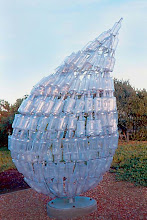Victoria Newhouse wrote a book called Art and the Power of Placement, which examines a piece of artwork in relation to its site. Though most of her work looks at the placement of paintings, she brings up several interesting discussions concerning various elements that an artist must take into consideration when placing his/her piece.
She describes how the location of a piece can completely change its meaning. In looking at Michelangelo's famous sculpture, David, she tells how it was originally commissioned to be built for a part of a cathedral. However, when the statue was almost complete, Michelangelo wanted to look for different sites for his piece, eventually finding a home in front of the city's town hall. Newhouse comments: "Had the David adorned the cathedral, he would have been a biblical hero; in front of the town hall, he became a symbol of the city government. Placed high up on a rostrum and parapet...next to the entrance portal and boldly facing south toward Rome, the David was seen by many in Florence as a warning to their Goliath: the exiled Medici who opposed the Florentine Republic." Her example of the David statue clearly shows how a piece of artwork can be interpreted differently based on its location.
Another example she gives her readers is that of the Elgin Marbles (Parthenon Marbles), a series of marble carvings once part of the Parthenon. The sculptures depict the birth of Athena and her competition with Poseidon. They were placed specifically at a high point, lining the cornice, intended to be seen from that viewpoint. The idea behind this was to show that the deities resided far above the mortal world, however, the statues were moved. The Elgin Marbles now reside in the British Museum at eye level, stripping the piece of its original significance as well as completely changing its surroundings. Furthermore, the figures no longer face outward, but instead "they now face each other across the gallery's interior, thereby destroying the narrative of the frieze and the overall processional relationship of the different groups to one another." Though the Marbles were moved due to reasons of preservation, we can see how their displacement causes them to lose their significance.
From these two examples, we can see how the site can truly affect a piece and how it has the ability to alter the meaning of the work entirely.
Reference:
Newhouse, Victoria. Art and the Power of Placement. New York: The Monacelli Press, 2005. Print.
Subscribe to:
Post Comments (Atom)










No comments:
Post a Comment